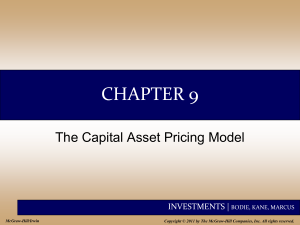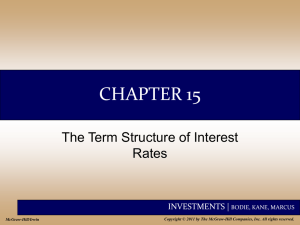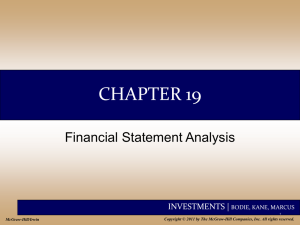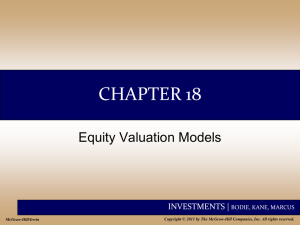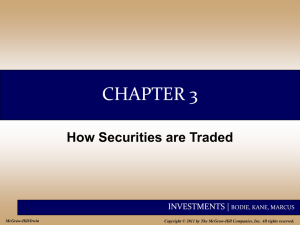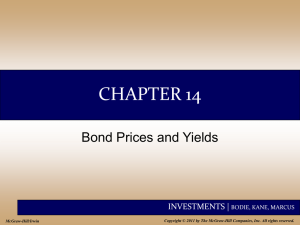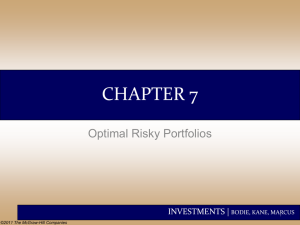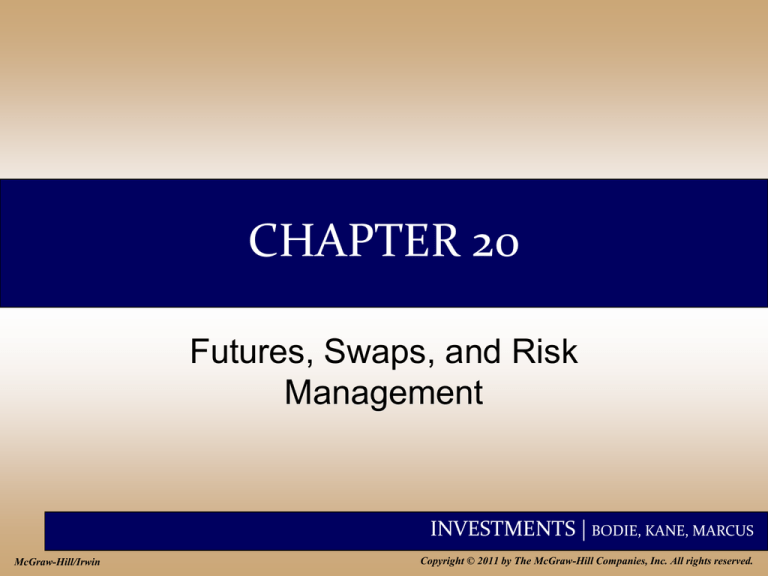
CHAPTER 20
Futures, Swaps, and Risk
Management
INVESTMENTS | BODIE, KANE, MARCUS
McGraw-Hill/Irwin
Copyright © 2011 by The McGraw-Hill Companies, Inc. All rights reserved.
20-2
Futures
• Futures can be used to hedge
specific sources of risk.
• Hedging instruments include:
– Foreign exchange futures
– Stock index futures
– Interest rate futures
– Swaps
– Commodity futures
INVESTMENTS | BODIE, KANE, MARCUS
20-3
Foreign Exchange Futures
• Foreign exchange risk: You may get more
or less home currency than you expected
from a foreign currency denominated
transaction.
• Foreign currency futures are traded on the
CME and the London International Futures
Exchange.
INVESTMENTS | BODIE, KANE, MARCUS
20-4
Figure 20.2 Foreign Exchange Futures
INVESTMENTS | BODIE, KANE, MARCUS
20-5
Pricing on Foreign Exchange Futures
•Interest rate parity theorem
Developed using the US Dollar and
British Pound
1 rUS
F0 E0
1 rUK
where
T
F0 is today’s forward rate
E0 is the current spot rate
INVESTMENTS | BODIE, KANE, MARCUS
20-6
Text Pricing Example
rus = 4%
ruk = 5%
E0 = $2.00 per pound
T = 1 yr
1
1.04
F0 $2.00
$1.981
1.05
If the futures price varies from $1.981 per
pound, covered interest arbitrage is
possible.
INVESTMENTS | BODIE, KANE, MARCUS
20-7
Direct Versus Indirect Quotes
• Direct exchange rate quote:
– The exchange rate is expressed as
dollars per unit of foreign currency
• Indirect exchange rate quote:
– The exchange rate is expressed as
foreign currency units per dollar
INVESTMENTS | BODIE, KANE, MARCUS
20-8
Hedging Foreign Exchange Risk
A US exporter wants to protect against
a decline in profit that would result from
depreciation of the pound. The current
futures price is $2/£1. Suppose FT =
$1.90?
•The exporter anticipates a profit loss of
$200,000 if the pound declines by $.10
•Short or sell pounds for future delivery
to avoid the exposure.
INVESTMENTS | BODIE, KANE, MARCUS
20-9
Hedge Ratio for Foreign Exchange
Example
Hedge Ratio in pounds
$200,000 per $.10 change in the pound/dollar exchange
rate
$.10 profit per pound delivered per $.10 in exchange rate
= 2,000,000 pounds to be delivered
Hedge Ratio in contracts
Each contract is for 62,500 pounds or $6,250 per a $.10 change
$200,000 / $6,250 = 32 contracts
INVESTMENTS | BODIE, KANE, MARCUS
20-10
Figure 20.3 Profits as a Function of the
Exchange Rate
INVESTMENTS | BODIE, KANE, MARCUS
20-11
Stock Index Contracts
• Available on both domestic and
international stocks
• Settled in cash
• Advantages over direct stock purchase
– lower transaction costs
– better for timing or allocation
strategies
– takes less time to acquire the
portfolio
INVESTMENTS | BODIE, KANE, MARCUS
20-12
Table 20.1 Major Stock-Index Futures
INVESTMENTS | BODIE, KANE, MARCUS
20-13
Table 20.2 Correlations among Major U.S.
Stock Market Indexes
INVESTMENTS | BODIE, KANE, MARCUS
20-14
Creating Synthetic Positions
with Futures
• Index futures let investors participate in
broad market movements without actually
buying or selling large amounts of stock.
• Results:
– Cheaper and more flexible
– Synthetic position; instead of holding or
shorting all of the actual stocks in the
index, you are long or short the index
futures
INVESTMENTS | BODIE, KANE, MARCUS
20-15
Creating Synthetic Positions
with Futures
• Speculators on broad market moves
are major players in the index futures
market.
– Strategy: Buy and hold T-bills and
vary the position in market-index
futures contracts.
– If bullish, then long futures
– If bearish, then short futures
INVESTMENTS | BODIE, KANE, MARCUS
20-16
Index Arbitrage
Exploiting mispricing between underlying
stocks and the futures index contract
• Futures Price too high - short the future
and buy the underlying stocks
• Futures price too low - long the future
and short sell the underlying stocks
INVESTMENTS | BODIE, KANE, MARCUS
20-17
Index Arbitrage and Program Trading
• This is difficult to implement in practice
– Transactions costs are often too large
– Trades cannot be done
simultaneously
• Development of Program Trading
– Used by arbitrageurs to perform index
arbitrage
– Permits quick acquisition of securities
INVESTMENTS | BODIE, KANE, MARCUS
20-18
Hedging Systematic Risk
To protect against a decline in stock
prices, short the appropriate number of
futures index contracts.
• Less costly and quicker
• Use the beta for the portfolio to
determine the hedge ratio.
INVESTMENTS | BODIE, KANE, MARCUS
20-19
Hedging Systematic Risk
Example
Portfolio Beta = .8
S&P 500 = 1,000
Decrease = 2.5%
S&P falls to 975
Portfolio Value = $30 million
Projected loss if market declines by 2.5% = (.8) (2.5%) = 2%
2% of $30 million = $600,000
Each S&P500 index contract will change $6,250 for a 2.5%
change in the index. (The contract multiplier is $250).
INVESTMENTS | BODIE, KANE, MARCUS
20-20
Hedge Ratio Example
H=
Change in the portfolio value
Profit on one futures contract
=
$600,000
= 96 contracts short
$6,250
INVESTMENTS | BODIE, KANE, MARCUS
20-21
Figure 20.4 Predicted Value of the Portfolio as
a Function of the Market Index
INVESTMENTS | BODIE, KANE, MARCUS
20-22
Uses of Interest Rate Hedges
• A bond fund manager may seek to
protect gains against a rise in rates.
• Corporations planning to issue debt
securities want to protect against a rise
in rates.
• A pension fund with large cash inflows
may hedge against a decline in rates for
a planned future investment.
INVESTMENTS | BODIE, KANE, MARCUS
20-23
Hedging Interest Rate Risk
Example
Portfolio value
= $10 million
Modified duration
= 9 years
If rates rise by 10 basis points (.1%), then
Change in value = ( 9 ) ( .1%) = .9% or $90,000
Price value of a basis point (PVBP) = $90,000 / 10
= $9,000 per basis point
INVESTMENTS | BODIE, KANE, MARCUS
20-24
Hedge Ratio Example
H=
PVBP for the portfolio
PVBP for the hedge vehicle
=
$9,000
$90
= 100 T-Bond
contracts
INVESTMENTS | BODIE, KANE, MARCUS
20-25
Hedging
• The T-bond contracts drive the interest
rate exposure of a bond position to zero.
• This is a market neutral strategy. Gains on
the T-bond futures offset losses on the
bond portfolio.
• The hedge is imperfect in practice
because of slippage – the yield spread
does not remain constant.
INVESTMENTS | BODIE, KANE, MARCUS
20-26
Figure 20.5 Yield Spread
INVESTMENTS | BODIE, KANE, MARCUS
20-27
Swaps
• An interest rate swap
• Swaps are multiperiod extensions of calls for exchanging
cash flows based on a
forward contracts.
fixed rate for cash flows
based on a floating
• Credit risk on swaps rate.
• The foreign exchange
swap calls for an
exchange of currencies
on several future dates.
INVESTMENTS | BODIE, KANE, MARCUS
20-28
Interest Rate Swap: Text Example
INVESTMENTS | BODIE, KANE, MARCUS
20-29
The Swap Dealer
• Dealer enters a swap with Company A
– Pays fixed rate and receives LIBOR
• Dealer enters another swap with
Company B
– Pays LIBOR and receives a fixed rate
• When two swaps are combined, dealer’s
position is effectively neutral on interest
rates.
INVESTMENTS | BODIE, KANE, MARCUS
20-30
Figure 20.6 Interest Rate Swap
INVESTMENTS | BODIE, KANE, MARCUS
20-31
Figure 20.7 Interest Rate Futures
INVESTMENTS | BODIE, KANE, MARCUS
20-32
Pricing on Swap Contracts
Swaps are essentially a series of forward
contracts.
We need to find the level annuity, F *, with the
same present value as the stream of annual
cash flows that would be incurred in a
sequence of forward rate agreements.
F1
F2
F*
F*
2
(1 y1 ) (1 y2 )
(1 y1 ) (1 y2 ) 2
INVESTMENTS | BODIE, KANE, MARCUS
20-33
Figure 20.8 Forward Contracts
versus Swaps
INVESTMENTS | BODIE, KANE, MARCUS
20-34
Credit Default Swaps
• Payment on a CDS is tied to the financial
status of one or more reference firms.
• Allows two counterparties to take
positions on the credit risk of those firms.
• Indexes of CDS have now been
introduced.
INVESTMENTS | BODIE, KANE, MARCUS
20-35
Commodity Futures Pricing
• General
principles that apply to stocks
apply to commodities. However…
• Carrying costs are more for
commodities.
• Spoilage is a concern.
INVESTMENTS | BODIE, KANE, MARCUS
20-36
Commodity Futures Pricing
Let F0 = futures price, P0 = cash price
of the asset , and C = Carrying cost
F0 P0 (1 rf ) C
Now define c C
P0
then :
F0 P0 (1 rf c)
INVESTMENTS | BODIE, KANE, MARCUS
20-37
Futures Pricing
• F0 = P0(1+rf+c) is a parity relationship for
commodities that are stored.
• The formula works great for an asset like
gold, but not for electricity or agricultural
goods which are impractical to stockpile.
INVESTMENTS | BODIE, KANE, MARCUS
20-38
Figure 20.9 Typical Agricultural Price
Pattern over the Season
INVESTMENTS | BODIE, KANE, MARCUS
20-39
Example 2.8 Commodity Futures
Pricing
• The T-bill rate is 5%,
the market risk
premium is 8%, and
the beta for orange
juice is 0.117.
• Orange juice discount
rate is 5% + .117(8%)
= 5.94%.
• Let the expected spot
price in 6 months be
$1.45.
$1.45/(1.0594)0.5
= $1.409 = PV juice
F0/(1.05)0.5
= 0.976F0 = PV futures
0.976F0 = $1.409
F0 =$1.444
INVESTMENTS | BODIE, KANE, MARCUS


